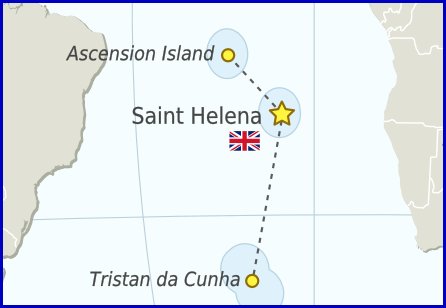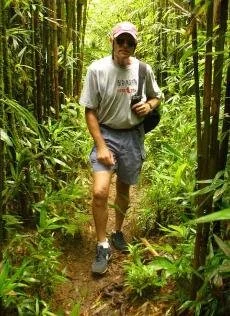Ascension Island ... Turtles, Letterboxes & Moonscapes
Located high upon the top of a 10,400’ high shield volcano, Ascension Island is unlike other South Atlantic British territories because it has no permanent inhabitants. It's a working island and its strategic location makes it a suitable venue for communication hubs and military bases... and a great rendezvous spot for breeding green turtles. We crossed the Atlantic Ocean for the second time from February-May 2007 and visited Ascension Island en route.
Three British Overseas Territories in the Atlantic that we visited
Ascension Island Facts
Capital and only city: Georgetown. There is one other ‘town’ called Two Boats.
Population: ~ 1,000; the island has never had an indigenous population and currently it is not possible to own land or a business there. It is a working island only although some worker/residents have lived there for decades.
Currency: St. Helena Pound (a/o 2007 - STH£ = BSP£ = $1.92 US)
High Point: Green Mountain (2,817')
Government: Under the administration of Saint Helena, Ascension is
officially a British Overseas Territory. The island has an appointed
Administrator who reports to the Governor, also appointed by the
British Crown. An Island Council is elected by the islanders to oversee
general island affairs.
Ascension Island lies in the South Atlantic about 700 miles northwest of Saint Helena and 500 miles south of the equator. Discovered in 1501 by the Portuguese and named Conception Island, it was re-discovered in 1503 by the French and named Ascension Island who didn’t realize (nor care) that the Portuguese had already discovered and named it . There was no permanent settlement at Ascension until Napoleon was imprisoned on St. Helena and by then the British controlled it and set up a garrison to aid St Helena in case an attempt was made by the French to free Napoleon.
A view from shore shows Cups all alone in the anchorage at Clarence Bay except for the freighter, which was anchored there all the while we were. Less than 24 boats a year call at Ascension. The pierhead and steps were originally constructed in 1829 and we doubted they had had any repairs since then! Long ropes at the bottom of the steps helped arrivals to get ashore like the Tarzan ropes at St. Helena, then a long line was used to tie up the dinghy and push it off the loading dock.
Scampering up the steep, sometimes slippery steps posed a few challenges, but we managed… though not always gracefully. The road into Georgetown from the pier is up an incline which seemed long on a hot, humid day. The ground here has been roughly bulldozed and is covered in a black, volcanic pumice stone readily available locally. The town of Georgetown itself is quite small. Other than administrative and functional buildings, there is a post office, a church, a small grocery, a hotel, a few small restaurants and not much else.
The government-run farm was privatized and by the 1990s, farming ceased on the island leaving the farm animals to go wild and wander about town… including donkeys which were very unwelcome at St. Mary’s Church.
Ascension is volcanic in origin and sits atop a 10,400’ high, 1,170’ wide shield volcano. The area close to sea level is volcanic with sparse vegetation and rough volcanic rubble. Paths and rough roads have been bulldozed out of the rubble and volcanic rock making the roads passable, but the walking tough. We tromped over volcanic debris for hours using the GPS to search unsuccessfully for a geocache. Our oldest son, Brennan, had turned us on to geocaching, a kind of GPS club. People hide a “cache” (watertight container of some sort with little trinkets in it) and list its GPS coordinates as well as some clues for finding the cache. Brennan determined there were actually two on Ascension and we set out to find them. The end result was that we could not find the one in Comfortless Cove. After spending nearly 4 hours getting there and searching around, we determined it was either too well hidden or someone else had found the cache and moved or destroyed it. Another day, we tried to find the second geocache. Again, we maneuvered across volcanic debris and a moon-like terrain and in and out of volcanic caves for nearly two hours in the blazing sun. Finally, in a little grotto beside a cave, David spotted a big container marked www.geocaching.com. There was all kinds of loot inside. We signed a “guest book”, took a deck of cards and left a Nine of Cups boat card and a Peruvian coin. So much for our geocaching adventures.
Green Turtles
Ascension is the most important breeding ground for the green turtle in the tropical Atlantic. Each year between January and May, 3,000-5,000 green turtles swim more than 1,200 miles from the coast of Brazil to mate and lay eggs on one of Ascension’s 32 sandy beaches.
Each morning the beaches show the tracks of females who have hauled themselves up on the beach the previous night to lay her eggs. We were allowed to come ashore one night at about 10PM to join a marine biology crew on the beach sands of Long Beach. We watched in awe as we witnessed the egg laying process one night. About 100 eggs are laid each time. The female goes into a trance during the laying process and she seemed oblivious to us. As one female was laying, hatchlings from another nest scurry by. It takes about 6-10 weeks for the eggs to hatch and the crew was helping the hatchlings make it to the water. After laying the eggs, the female spends hours covering the eggs with sand using her strong flippers as hands to scoop the sand. Only 1 in 1,000 eggs mature and return to Ascension Island to complete the breeding process. The hatching temperature determines the sex of the turtle.
The old walled turtle ponds or kraals above and some old photos from the museum show the historical importance of turtle meat to the island during the old shipping days. After laying her eggs, men would turn the turtle on her back until morning. Floats would then be tied around her so that she couldn’t dive and could easily be picked up by boats off shore. The turtles would be moved to the turtle ponds and kept in captivity until purchased by passing boats for fresh meat. In 1822, over 1,500 turtles were taken but by the 1860s, the population had dwindled dramatically. The last capture
of a green turtle was documented in 1950. Now they are a protected species by local and international law.
A little trivia… Captain James Cook stopped at Ascension in 1775 to collect turtle meat. Charles Darwin on the HMS Beagle wrote an account of the island’s geology. Prince Andrew visited as did the world famous sailing vessel, Nine of Cups and crew.
Letterbox Walks
Though the sea level area of the island was volcanic rubble, the top of the island is like a tropical rain forest, lush and green, hence the name Green Mountain Park. There are more than 20 “Letterbox Walks” on the island whereby hikers follow a marked trail and at the end, there is a letterbox with a stamp and visitor registration book. Souvenir books are sold to collect stamps or you can just stamp your journal. We thought it sounded fun. We rented a car to drive around the island and tried a few of the walks.
It’s a Working Island
Among other communication agencies, there’s a BBC Atlantic Relay Earth Station with huge satellite dishes to prove it. There's also a rather unimpressive US Air Force Base on the island where we stopped for a burger and beer. The topography is moon like and NASA had a
tracking station here as well. We never did find the topless beach! There’s even a 9-hole golf course on Ascension which held the distinction of being in Guiness’ Book of World Records as the “worst golf club in the world”. There were no greens on this golf course, only flat expanses of volcanic pumice.
One of the special people we met was Susanna Musick, an American turtle biologist who had just arrived from the States for a two-year stint here as Head Conservation Officer. She came out to Cups for pizza one night before we left.
Our last day on the island was spent at the little
Ascension Museum only open 11am-1pm on
Saturdays. The museum included a tour of the
historic, but rather dilapidated Ft.Hayes built on
Goat Hill by the British in the 1860s.
We hauled anchor on Sunday, 25 March, 2007. A lazy departure as we watched a cruise ship, the Van Gogh, shuttle people to shore for their 6 hours of land time…no Green Mountain Park or turtle watching for them. David hauled the anchor manually... the windlass was broken and this time David determined it was not reparable. We decided to head straight to the States without a stop in the Caribbean and set our course for the Equator and then for Charleston, SC. Southeast trades carried us off the island and soon it had vanished from sight. We were at sea again.





































